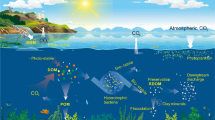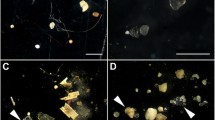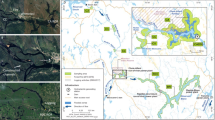Abstract
Dissolved organic carbon (DOC) in large river networks is an important carbon pool in the global biogeochemical cycle. DOC compositions vary spatially at global and regional scales, which influences DOC degradation and subsequent in-stream removal in river networks. The Changjiang River Network (CRN) is the third largest river system worldwide and plays an important role in DOC transformation and transportation. However, the relationships between DOC composition and degradation, as well as the quantification of in-stream removal, remain poorly understood. In this study, we chose the CRN to study spatial patterns of DOC fluorescence, as proxies for chemical composition, and degradation. Laboratory degradation experiments were conducted to explore DOC degradability and mechanisms of photodegradation and microbial respiration. We found that DOC fluorescence properties and degradation showed significant spatial differences in the lower reaches of the CRN. DOC with higher proportions of humic acid-like materials showed higher photodegradability. In degradation experiments, the total DOC loss was 49.1–66.0% over about the first 6 to 7 days. Microbial respiration removed 33.0–47.3% of total DOC, while photodegradation removed 9.0–35.3%. The relative contributions of photodegradation and microbial respiration to DOC degradation varied with different DOC fluorescence properties. The experimental values of DOC decay rate constants were 0.217–0.250 d−1. Our study improves understanding of DOC degradability, linking to its composition and providing a reference for estimating DOC in-stream removal in large river networks.







Similar content being viewed by others
References
Abril G et al (2014) Amazon River carbon dioxide outgassing fuelled by wetlands. Nature 505:395–398. https://doi.org/10.1038/nature12797
Aiken GR, Spencer RGM, Striegl RG, Schuster PF, Raymond PA (2014) Influences of glacier melt and permafrost thaw on the age of dissolved organic carbon in the Yukon River basin. Global Biogeochem Cy 28:525–537. https://doi.org/10.1002/2013gb004764
Artinger R, Buckau G, Geyer S, Fritz P, Wolf M, Kim JI (2000) Characterization of groundwater humic substances: influence of sedimentary organic carbon. Appl Geochem 15:97–116. https://doi.org/10.1016/s0883-2927(99)00021-9
Balcarczyk KL, Jones JB, Jaffe R, Maie N (2009) Stream dissolved organic matter bioavailability and composition in watersheds underlain with discontinuous permafrost. Biogeochemistry 94:255–270. https://doi.org/10.1007/s10533-009-9324-x
Baldwin DS, Whitworth KL, Hockley CL (2014) Uptake of dissolved organic carbon by biofilms provides insights into the potential impact of loss of large woody debris on the functioning of lowland rivers. Freshw Biol 59:692–702. https://doi.org/10.1111/fwb.12296
Bao HY, Wu Y, Zhang J (2015) Spatial and temporal variation of dissolved organic matter in the Changjiang: fluvial transport and flux estimation. J Geophys Res Biogeosci 120:1870–1886. https://doi.org/10.1002/2015jg002948
Casas-Ruiz JP et al (2017) A tale of pipes and reactors: controls on the in-stream dynamics of dissolved organic matter in rivers. Limnol Oceanogr 62:S85–S94. https://doi.org/10.1002/lno.10471
Catalán N, Obrador B, Felip M, Pretus JL (2013) Higher reactivity of allochthonous vs. autochthonous DOC sources in a shallow lake. Aquat Sci 75:581–593. https://doi.org/10.1007/s00027-013-0302-y
Chen M, Jaffe R (2014) Photo- and bio-reactivity patterns of dissolved organic matter from biomass and soil leachates and surface waters in a subtropical wetland. Water Res 61:181–190. https://doi.org/10.1016/j.watres.2014.03.075
Chen W, Westerhoff P, Leenheer JA, Booksh K (2003) Fluorescence excitation-emission matrix regional integration to quantify spectra for dissolved organic matter. Environ Sci Technol 37:5701–5710. https://doi.org/10.1021/es034354c
Chen H, Meng W, Zheng B-h, Wang C-y, An L-h (2013) Optical signatures of dissolved organic matter in the watershed of a globally large river (Yangtze River, China). Limnologica - Ecology and Management of Inland Waters 43:482–491. https://doi.org/10.1016/j.limno.2013.04.004
Chow AT, Pitt AL, Baldwin RF, Suhre D, Wang J-J (2016) Water quality dynamics of ephemeral wetlands in the Piedmont ecoregion, South Carolina, USA. Ecol Eng 94:555–563. https://doi.org/10.1016/j.ecoleng.2016.06.075
Coble PG (1996) Characterization of marine and terrestrial DOM in seawater using excitation emission matrix spectroscopy. Mar Chem 51:325–346. https://doi.org/10.1016/0304-4203(95)00062-3
Cory RM, Kaplan LA (2012) Biological lability of streamwater fluorescent dissolved organic matter. Limnol Oceanogr 57:1347–1360. https://doi.org/10.4319/lo.2012.57.5.1347
Cory RM, Kling GW (2018) Interactions between sunlight and microorganisms influence dissolved organic matter degradation along the aquatic continuum. Limnology and Oceanography Letters 3:102–116. https://doi.org/10.1002/lol2.10060
Cory RM, Ward CP, Crump BC, Kling GW (2014) Carbon cycle. Sunlight controls water column processing of carbon in arctic fresh waters. Science 345:925–928. https://doi.org/10.1126/science.1253119
D’Andrilli J, Junker JR, Smith HJ, Scholl EA, Foreman CM (2019) DOM composition alters ecosystem function during microbial processing of isolated sources. Biogeochemistry 142:281–298. https://doi.org/10.1007/s10533-018-00534-5
Dai MH, Yin ZQ, Meng FF, Liu Q, Cai WJ (2012) Spatial distribution of riverine DOC inputs to the ocean: an updated global synthesis. Current Opinion in Environmental Sustainability 4:170–178. https://doi.org/10.1016/j.cosust.2012.03.003
Dalmagro HJ, Johnson MS, de Musis CR, Lathuilliere MJ, Graesser J, Pinto OB, Couto EG (2017) Spatial patterns of DOC concentration and DOM optical properties in a Brazilian tropical river-wetland system. J Geophys Res Biogeosci 122:1883–1902. https://doi.org/10.1002/2017jg003797
D’Amore DV, Fellman JB, Edwards RT, Hood E (2010) Controls on dissolved organic matter concentrations in soils and streams from a forested wetland and sloping bog in southeast Alaska. Ecohydrology 3:249–261. https://doi.org/10.1002/eco.101
del Giorgio PA, Pace ML (2008) Relative independence of organic carbon transport and processing in a large temperate river: the Hudson River as both pipe and reactor. Limnol Oceanogr 53:185–197. https://doi.org/10.4319/lo.2008.53.1.0185
Dittmar T, Hertkorn N, Kattner G, Lara RJ (2006) Mangroves, a major source of dissolved organic carbon to the oceans. Global Biogeochem Cycles. https://doi.org/10.1029/2005gb002570
Eckard RS, Pellerin BA, Bergamaschi BA, Bachand PAM, Bachand SM, Spencer RGM, Hernes PJ (2017) Dissolved Organic Matter Compositional Change and Biolability During Two Storm Runoff Events in a Small Agricultural Watershed. Journal of Geophysical Research-Biogeosciences 122:2634–2650. https://doi.org/10.1002/2017jg003935
Ejarque E et al (2017) Quality and reactivity of dissolved organic matter in a Mediterranean river across hydrological and spatial gradients. Sci Total Environ 599:1802–1812. https://doi.org/10.1016/j.scitotenv.2017.05.113
Ensign SH, Doyle MW (2006) Nutrient spiraling in streams and river networks. Journal of Geophysical Research-Biogeosciences. https://doi.org/10.1029/2005jg000114
Fellman JB, Hood E, D’Amore DV, Edwards RT, White D (2009) Seasonal changes in the chemical quality and biodegradability of dissolved organic matter exported from soils to streams in coastal temperate rainforest watersheds. Biogeochemistry 95:277–293. https://doi.org/10.1007/s10533-009-9336-6
Girkin NT et al (2019) Spatial variability of organic matter properties determines methane fluxes in a tropical forested peatland. Biogeochemistry 142:231–245. https://doi.org/10.1007/s10533-018-0531-1
Hellauer K, Mayerlen SM, Drewes JE, Huebner U (2019) Biotransformation of trace organic chemicals in the presence of highly refractory dissolved organic carbon. Chemosphere 215:33–39. https://doi.org/10.1016/j.chemosphere.2018.09.166
Hernes PJ, Bergamaschi BA, Eckard RS, Spencer RGM (2009) Fluorescence-based proxies for lignin in freshwater dissolved organic matter. J Geophys Res Biogeosci. https://doi.org/10.1029/2009jg000938
Hotchkiss ER, Hall RO, Baker MA, Rosi-Marshall EJ, Tank JL (2014) Modeling priming effects on microbial consumption of dissolved organic carbon in rivers. J Geophys Res Biogeosci 119:982–995. https://doi.org/10.1002/2013jg002599
Jaffé R et al (2012) Dissolved organic matter in headwater streams: compositional variability across climatic regions of North America. Geochim Cosmochim Acta 94:95–108. https://doi.org/10.1016/j.gca.2012.06.031
Kellerman AM, Dittmar T, Kothawala DN, Tranvik LJ (2014) Chemodiversity of dissolved organic matter in lakes driven by climate and hydrology. Nat Commun. https://doi.org/10.1038/ncomms4804
Kim EA, Lee HK, Choi JH (2017) Effects of a controlled freeze-thaw event on dissolved and colloidal soil organic matter. Environ Sci Pollut Res 24:1338–1346. https://doi.org/10.1007/s11356-016-7552-x
Koehler B, von Wachenfeldt E, Kothawala D, Tranvik LJ (2012) Reactivity continuum of dissolved organic carbon decomposition in lake water. J Geophys Res Biogeosci. https://doi.org/10.1029/2011jg001793
Koehler B, Landelius T, Weyhenmeyer GA, Machida N, Tranvik LJ (2014) Sunlight-induced carbon dioxide emissions from inland waters. Global Biogeochem Cycles 28:696–711. https://doi.org/10.1002/2014gb004850
Kubo A, Yamamoto-Kawai M, Kanda J (2015) Seasonal variations in concentration and lability of dissolved organic carbon in Tokyo Bay. Biogeosciences 12:269–279. https://doi.org/10.5194/bg-12-269-2015
Larson JH, Frost PC, Zheng Z, Johnston CA, Bridgham SD, Lodge DM, Lamberti GA (2007) Effects of upstream lakes on dissolved organic matter in streams. Limnol Oceanogr 52:60–69. https://doi.org/10.4319/lo.2007.52.1.0060
Laudon H et al (2011) Patterns and dynamics of dissolved organic carbon (DOC) in boreal streams: the role of processes, connectivity, and scaling. Ecosystems 14:880–893. https://doi.org/10.1007/s10021-011-9452-8
Li XY, Yang LB, Yan WJ (2011) Model analysis of dissolved inorganic phosphorus exports from the Yangtze river to the estuary. Nutr Cycl Agroecosyst 90:157–170. https://doi.org/10.1007/s10705-010-9419-8
Liu K-K, Yan W, Lee H-J, Chao S-Y, Gong G-C, Yeh T-Y (2015) Impacts of increasing dissolved inorganic nitrogen discharged from Changjiang on primary production and seafloor oxygen demand in the East China Sea from 1970 to 2002. J Mar Syst 141:200–217. https://doi.org/10.1016/j.jmarsys.2014.07.022
Lonborg C, Álvarez-Salgado XA, Davidson K, Martínez-García S, Teira E (2010) Assessing the microbial bioavailability and degradation rate constants of dissolved organic matter by fluorescence spectroscopy in the coastal upwelling system of the Ría de Vigo. Mar Chem 119:121–129. https://doi.org/10.1016/j.marchem.2010.02.001
Lu X, Jaffe R (2001) Interaction between Hg(II) and natural dissolved organic matter: a fluorescence spectroscopy based study. Water Res 35:1793–1803
Lu Y, Bauer JE, Canuel EA, Yamashita Y, Chambers RM, Jaffé R (2013) Photochemical and microbial alteration of dissolved organic matter in temperate headwater streams associated with different land use. J Geophys Res Biogeosci 118:566–580. https://doi.org/10.1002/jgrg.20048
Manninen N, Soinne H, Lemola R, Hoikkala L, Turtola E (2018) Effects of agricultural land use on dissolved organic carbon and nitrogen in surface runoff and subsurface drainage. Sci Total Environ 618:1519–1528. https://doi.org/10.1016/j.scitotenv.2017.09.319
Marschner B, Kalbitz K (2003) Controls of bioavailability and biodegradability of dissolved organic matter in soils. Geoderma 113:211–235. https://doi.org/10.1016/s0016-7061(02)00362-2
Mayorga E et al (2005) Young organic matter as a source of carbon dioxide outgassing from Amazonian rivers. Nature 436:538–541. https://doi.org/10.1038/nature03880
McKnight DM, Boyer EW, Westerhoff PK, Doran PT, Kulbe T, Andersen DT (2001) Spectrofluorometric characterization of dissolved organic matter for indication of precursor organic material and aromaticity. Limnol Oceanogr 46:38–48. https://doi.org/10.4319/lo.2001.46.1.0038
Mineau MM et al (2016) Dissolved organic carbon uptake in streams: a review and assessment of reach-scale measurements. J Geophys Res Biogeosci 121:2019–2029. https://doi.org/10.1002/2015jg003204
Moody CS, Worrall F (2015) Sub-daily rates of degradation of fluvial carbon from a peat headwater stream. Aquat Sci 78:419–431. https://doi.org/10.1007/s00027-015-0456-x
Mostovaya A, Koehler B, Guillemette F, Brunberg A-K, Tranvik LJ (2016) Effects of compositional changes on reactivity continuum and decomposition kinetics of lake dissolved organic matter. J Geophys Res Biogeosci 121:1733–1746. https://doi.org/10.1002/2016jg003359
Mounier S, Braucher R, Benaim JY (1999) Differentiation of organic matter’s properties of the Rio Negro basin by crossflow ultra-filtration and UV-spectrofluorescence. Water Res 33:2363–2373. https://doi.org/10.1016/s0043-1354(98)00456-4
Naganuma T, Konishi S, Inoue T, Nakane T, Sukizaki S (1996) Photodegradation or photoalteration? Microbial assay of the effect of UV-B on dissolved organic matter. Mar Ecol Prog Ser 135:309–310. https://doi.org/10.3354/meps135309
Nahlik AM, Mitsch WJ (2011) Methane emissions from tropical freshwater wetlands located in different climatic zones of Costa Rica. Glob Change Biol 17:1321–1334. https://doi.org/10.1111/j.1365-2486.2010.02190.x
Nguyen HV-M, Hur J, Shin H-S (2010) Changes in spectroscopic and molecular weight characteristics of dissolved organic matter in a river during a storm event. Water Air Soil Pollut 212:395–406. https://doi.org/10.1007/s11270-010-0353-9
Obernosterer I, Benner R (2004) Competition between biological and photochemical processes in the mineralization of dissolved organic carbon. Limnol Oceanogr 49:117–124. https://doi.org/10.4319/lo.2004.49.1.0117
Obernosterer I, Reitner B, Herndl GJ (1999) Contrasting effects of solar radiation on dissolved organic matter and its bioavailability to marine bacterioplankton. Limnol Oceanogr 44:1645–1654. https://doi.org/10.4319/lo.1999.44.7.1645
Osburn CL, Oviedo-Vargas D, Barnett E, Dierick D, Oberbauer SF, Genereux DP (2018) Regional groundwater and storms are hydrologic controls on the quality and export of dissolved organic matter in two tropical rainforest streams, Costa Rica. J Geophys Res Biogeosci 123:850–866. https://doi.org/10.1002/2017jg003960
Pellerin BA, Saraceno JF, Shanley JB, Sebestyen SD, Aiken GR, Wollheim WM, Bergamaschi BA (2012) Taking the pulse of snowmelt: in situ sensors reveal seasonal, event and diurnal patterns of nitrate and dissolved organic matter variability in an upland forest stream. Biogeochemistry 108:183–198. https://doi.org/10.1007/s10533-011-9589-8
Peterson BJ et al (2001) Control of nitrogen export from watersheds by headwater streams. Science 292:86–90. https://doi.org/10.1126/science.1056874
Petrone KC, Richards JS, Grierson PF (2009) Bioavailability and composition of dissolved organic carbon and nitrogen in a near coastal catchment of south-western Australia. Biogeochemistry 92:27–40. https://doi.org/10.1007/s10533-008-9238-z
Petrone KC, Fellman JB, Hood E, Donn MJ, Grierson PF (2011) The origin and function of dissolved organic matter in agro-urban coastal streams. J Geophys Res Biogeosci 116:1–13. https://doi.org/10.1029/2010jg001537
Pollard PC (2013) In situ rapid measures of total respiration rate capture the super labile DOC bacterial substrates of freshwater. Limnol Oceanogr Methods 11:584–593. https://doi.org/10.4319/lom.2013.11.584
Raymond PA, Saiers JE (2010) Event controlled DOC export from forested watersheds. Biogeochemistry 100:197–209. https://doi.org/10.1007/s10533-010-9416-7
Raymond PA et al (2013) Global carbon dioxide emissions from inland waters. Nature 503:355–359. https://doi.org/10.1038/nature12760
Regnier P et al (2013) Anthropogenic perturbation of the carbon fluxes from land to ocean. Nat Geosci 6:597–607. https://doi.org/10.1038/Ngeo1830
Rothwell JJ, Evans MG, Allott TEH (2007) In-stream processing of sediment-associated metals in peatland fluvial systems. Water Air Soil Pollut 187:53–64. https://doi.org/10.1007/s11270-007-9496-8
Santin C, Yamashita Y, Otero XL, Alvarez MA, Jaffe R (2009) Characterizing humic substances from estuarine soils and sediments by excitation-emission matrix spectroscopy and parallel factor analysis. Biogeochemistry 96:131–147. https://doi.org/10.1007/s10533-009-9349-1
Seitzinger SP et al (2002) Nitrogen retention in rivers: model development and application to watersheds in the northeastern U.S.A. Biogeochemistry 57:199–237. https://doi.org/10.1023/a:1015745629794
Stets EG, Striegl RG, Aiken GR (2010) Dissolved organic carbon export and internal cycling in small, headwater lakes. Global Biogeochem Cycles. https://doi.org/10.1029/2010gb003815
Stubbins A, Lapierre JF, Berggren M, Prairie YT, Dittmar T, del Giorgio PA (2014) What’s in an EEM? Molecular signatures associated with dissolved organic fluorescence in boreal Canada. Environ Sci Technol 48:10598–10606. https://doi.org/10.1021/es502086e
Sulzberger B, Durisch-Kaiser E (2009) Chemical characterization of dissolved organic matter (DOM): a prerequisite for understanding UV-induced changes of DOM absorption properties and bioavailability. Aquat Sci 71:104–126. https://doi.org/10.1007/s00027-008-8082-5
Tank JL, Rosi-Marshall EJ, Baker MA, Hall RO (2008) Are rivers just big streams? A pulse method to quantify nitrogen demand in a large river. Ecology 89:2935–2945. https://doi.org/10.1890/07-1315.1
Tipping E, Billett MF, Bryant CL, Buckingham S, Thacker SA (2010) Sources and ages of dissolved organic matter in peatland streams: evidence from chemistry mixture modelling and radiocarbon data. Biogeochemistry 100:121–137. https://doi.org/10.1007/s10533-010-9409-6
Vähätalo AV, Wetzel RG (2004) Photochemical and microbial decomposition of chromophoric dissolved organic matter during long (months-years) exposures. Mar Chem 89:313–326. https://doi.org/10.1016/j.marchem.2004.03.010
Vouvé F, Cotrim da Cunha L, Serve L, Vigo J, Salmon J-M (2009) Spatio-temporal variations of fluorescence properties of dissolved organic matter along the River Têt (Pyrénées-Orientales, France). Chem Ecol 25:435–452. https://doi.org/10.1080/02757540903325104
Wada S et al (2008) Bioavailability of macroalgal dissolved organic matter in seawater. Mar Ecol Prog Ser 370:33–44. https://doi.org/10.3354/meps07645
Wang XC, Ma HQ, Li RH, Song ZS, Wu JP (2012) Seasonal fluxes and source variation of organic carbon transported by two major Chinese Rivers: the Yellow River and Changjiang (Yangtze) River. Global Biogeochem Cycles. https://doi.org/10.1029/2011gb004130
Wang J, Yan W, Chen N, Li X, Liu L (2015) Modeled long-term changes of DIN:DIP ratio in the Changjiang River in relation to Chl-α and DO concentrations in adjacent estuary. Estuar Coast Shelf Sci 166:153–160. https://doi.org/10.1016/j.ecss.2014.11.028
Wang H, Jiao R, Wang F, Zhang L, Yan W (2016) Dissolved organic carbon content and characteristics in relation to carbon dioxide partial pressure across Poyang Lake wetlands and adjacent aquatic systems in the Changjiang basin. Environ Pollut 219:714–723. https://doi.org/10.1016/j.envpol.2016.07.012
Wang WL, Zhang X, Wu QY, Du Y, Hu HY (2017) Degradation of natural organic matter by UV/chlorine oxidation: molecular decomposition, formation of oxidation byproducts and cytotoxicity. Water Res 124:251–258. https://doi.org/10.1016/j.watres.2017.07.029
Webster JR, Meyer JL (1997) Organic matter budgets for streams: a synthesis. J North Am Benthol Soc 16:141–161. https://doi.org/10.2307/1468247
Weishaar JL, Aiken GR, Bergamaschi BA, Fram MS, Fujii R, Mopper K (2003) Evaluation of specific ultraviolet absorbance as an indicator of the chemical composition and reactivity of dissolved organic carbon. Environ Sci Technol 37:4702–4708. https://doi.org/10.1021/es030360x
Wollheim WM, Voosmarty CJ, Peterson BJ, Seitzinger SP, Hopkinson CS (2006) Relationship between river size and nutrient removal. Geophys Res Lett. https://doi.org/10.1029/2006gl025845
Worrall F, Howden NJK, Burt TP, Bartlett R (2018) Declines in the dissolved organic carbon (DOC) concentration and flux from the UK. J Hydrol 556:775–789. https://doi.org/10.1016/j.jhydrol.2017.12.001
Wu F, Cai Y, Evans D, Dillon PJ (2004) Complexation between Hg(II) and dissolved organic matter in stream waters: an application of fluorescence spectroscopy. Biogeochemistry 71:339–351
Wu Y, Zhang J, Liu SM, Zhang ZF, Yao QZ, Hong GH, Cooper L (2007) Sources and distribution of carbon within the Yangtze River system. Estuar Coast Shelf Sci 71:13–25. https://doi.org/10.1016/j.ecss.2006.08.016
Yan WJ, Mayorga E, Li XY, Seitzinger SP, Bouwman AF (2010) Increasing anthropogenic nitrogen inputs and riverine DIN exports from the Changjiang River basin under changing human pressures. Global Biogeochem Cycles. https://doi.org/10.1029/2009gb003575
Yan MQ, Fu QW, Li DC, Gao GF, Wang DS (2013) Study of the pH influence on the optical properties of dissolved organic matter using fluorescence excitation-emission matrix and parallel factor analysis. J Lumin 142:103–109. https://doi.org/10.1016/j.jlumin.2013.02.052
Yang L, Zhuang W-E, Chen C-TA, Wang B-J, Kuo F-W (2017) Unveiling the transformation and bioavailability of dissolved organic matter in contrasting hydrothermal vents using fluorescence EEM-PARAFAC. Water Res 111:195–203. https://doi.org/10.1016/j.watres.2017.01.001
Zhang LJ, Xue M, Wang M, Cai WJ, Wang L, Yu ZG (2014) The spatiotemporal distribution of dissolved inorganic and organic carbon in the main stem of the Changjiang (Yangtze) River and the effect of the Three Gorges Reservoir. J Geophys Res Biogeosci 119:741–757. https://doi.org/10.1002/2012jg002230
Zhao Y, Song K, Shang Y, Shao T, Wen Z, Lv L (2017) Characterization of CDOM of river waters in China using fluorescence excitation-emission matrix and regional integration techniques. J Geophys Res Biogeosci 122:1940–1953. https://doi.org/10.1002/2017jg003820
Acknowledgements
The work by Weijin Yan in this study was supported by the National Key Research and Development Program of China through Grant 2016YFA0601004, and the National Natural Science Foundation of China (41877483, 21177126). The work by Yuchun Wang was supported by the National Natural Science Foundation of China (91647208, U1802241).
Author information
Authors and Affiliations
Corresponding author
Additional information
Responsible Editor: Jack Brookshire
Publisher's Note
Springer Nature remains neutral with regard to jurisdictional claims in published maps and institutional affiliations.
Rights and permissions
About this article
Cite this article
Lv, S., Wang, F., Yan, W. et al. DOC fluorescence properties and degradation in the Changjiang River Network, China: implications for estimating in-stream DOC removal. Biogeochemistry 145, 255–273 (2019). https://doi.org/10.1007/s10533-019-00603-3
Received:
Accepted:
Published:
Issue Date:
DOI: https://doi.org/10.1007/s10533-019-00603-3




